
National Fire Plan Success Story
Fuels Management and Wildlife
Partnerships and Volunteers
Olympic National Forest, Western Washington
National Fire Plan - Fuels Reduction
2009

Clallam County AmeriCorps help build piles at Caraco meadows.

Volunteers plant willows and Red Elderberry shoots to recreate native foliage diversity in Caraco meadows.
The Olympic National Forest (NF) has been a key participant in long-term projects aimed at benefiting both local communities and wildlife. An example is elk habitat enhancement on 25 acres in the Caraco Creek area just south of the community of Sequim. Historically this area was used by elk for calving and winter range. Recently elk herds have migrated into the community of Sequim due to conifer encroachment into the native meadows.
Olympic NF wildlife biologists and fire management staff, with the combined support of the Washington Conservation Corps, Clallam County AmeriCorps, and the Rocky Mountain Elk Foundation, have taken actions to return these historic meadows to their original state. These actions include cutting and piling of regenerating conifers, and planting of willow and red elderberry. Fire staff will burn the piles of cut conifers later this fall, and will conduct periodic broadcast burns in the meadows for long-term maintenance. Wildlife Biologists and volunteers will then re-seed these areas with native plants, such as pearly everlasting and fireweed.
Positive results have already been observed from the on-going project. A variety of wildlife, such as deer, doves, nighthawks, grouse, and black bear, have begun to use the meadows. This collective use is an excellent indicator of habitat improvement and also an indicator that elk will likely soon return to Caraco meadows in the future.
For more information contact, Tyler Bentley at 360-956-2390, or at tbentley@fs.fed.us.